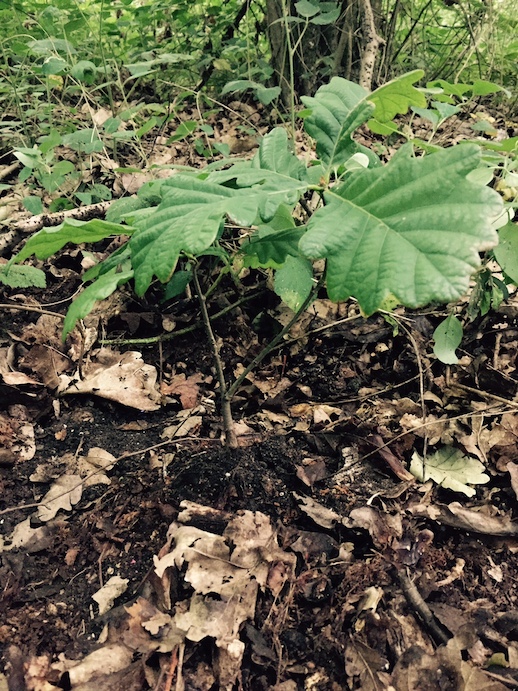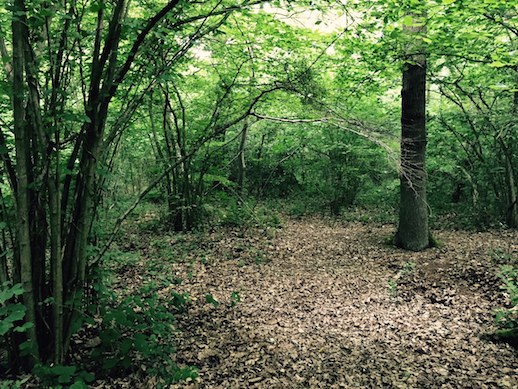A year writing about Oxleas Woods in south east London took Emma Warren somewhere unexpected – to a series of solstice celebrations. Here she concludes her story in the place it all began:
Before I knew it, the summer solstice had come around. As usual my good intentions diminished in a rushed gathering-together of what I had at hand, especially as my fellow solstice investigators had all fallen away – one locked in the edit suite, one out of town, two otherwise engaged.
The plan was to mark the moment of solstice, of sun-stopping, where the ancients believed the sun halted and began moving in the opposite direction. This moment was at 5.39pm on the 21st of June, the moment when the earth came closest to the sun before starting its gradual move away. It’s a move that can be marked in seconds of light – tomorrow night would be one second longer than tonight, and so on until it gets dark at teatime and we’re back at another solstice, ready to start the year all over again.
Like all these celebrations, midsummer has a theme. If the spring festivals are predominantly about the female form, and Beltane’s about the coming together of metaphorical man and woman, then midsummer is all man. It’s oak o’clock. It occurred to me as I pegged it up to the woods, running late for my solstice deadline, that I had an oak sapling at home that I’d grown from an Oxleas acorn. It was a strong looking thing, 18 months old with fat leaves and a promising stem that was trunking up. I had it in a large plastic pot with some rocket, so I went back and carefully tipped the whole thing; earth, sapling and rocket, into a Sainbury’s bag and jumped in the car.
The view from Oxleas Café is a lovely thing. You’ve got the oldest part of the woods to your left and the secondary woodland of Jack Wood and Castle Wood, to your right. Directly in front is a view out towards Sidcup, Orpington and Croydon and then onwards to the South Downs and the coast. Lower your gaze and there’s Oxleas Meadow, and over in the bottom left hand corner are two oaks that have leapfrogged the main body of the woods and stand alone, in a line of two, measuring out space in the grass like bollards or traffic lights.
I make my way down the slope of the meadow swinging my Sainsbury’s bag full of tree in an attempt to make it look less conspicuous. It’s a slightly illicit return for this acorn which came from here, but which grew up on my balcony and I sit under the traffic light oak, with ten minutes to spare until midsummer.
I’m not very good at sitting still so I start digging into the soil in the Sainsbury’s bag to disentangle the rocket from the oak roots. I follow the capillaries and the bleached white taproot with my fingers and gently prise them apart. There’s a family coming out of bottom entrance of the woods, a boy in a red T-shirt tussling with his dog whilst his parents lag behind, lead dragging behind them like it’s carrying something small and invisible. It’s cloudy, but the lower section of the sky is emitting crepuscular rays like half a wry smile.
It’s 5.37. Then 5.38. I close my eyes and sit there. My phone rings, and appropriately enough for a moment that celebrates the masculine power of the sun, it’s my nearly-man son. It’s 5.40, and the world has tipped into solar retreat.
The woods however are in full green and walking into them is like walking through a series of vast green curtains. Sound travels differently in here as the air is stilled by the layered walls of vegetation. The trees and bushes are like sound proofing in a recording studio, absorbing the wind and the traffic noises so that we get a slowed down, softer version of the outside world.
I’m looking for the clearing where we performed our winter solstice celebration six months ago. We’d ended up in the spot by accident, through a combination of walking through the woods in the dusk and trying to find a flat, clear space where we wouldn’t be disturbed. I knew roughly where we’d gone, but I hadn’t been back since. I followed my memory and ended up on a side path, looking into a small patch of leaf litter surrounded by hazel shoots, the remains of a small waterway and an ash that is so tall and slender and strong that it looks built, not grown. It’s a perfect natural maypole, something I hadn’t noticed when we were scurrying around its base in midwinter, planting garlic blubs and toasting the woods with Duppy Share rum. I put down the Sainbury’s bag with the tree nestled inside, which is good because it was quite heavy, and the tree lollops to one side, leaves pointing out into the woods.
The garlic we planted doesn’t appear to have survived. I carve out semi-circular distrails in the leaves with my foot, looking for the bulb I planted under the tree but I can’t find it. They didn’t take, or we planted them upside down, or maybe the rats ate them, either way there’s no midsummer harvest here. I’ll try again next year.
There is planting to be done, despite the failed garlic harvest. My first attempt at plugging my sapling back into the motherland doesn’t work. The ground is too hard and rooty and I’ve only brought a trowel. I might as well have tried to dig with my credit card and a spoon. I move to a damper spot, close to what might be a small waterway in the winter. I dig into and around intricate webs of leaf mulch and hazel roots, peppered with round fungal spores and disconnected acorn cups, and put the tree in the space that has opened up in the ground. I’m looking into the unknown, into sub-soils and years-old woodland trash that probably hasn’t been seen by a human ever before. These views that you only get in the woods, of bark right up close or of the insides of a hazel stand are fascinating not least because they’re so unseen.
Last time we burned a recipe for midwinter incense, but I’m doing this one solo so haven’t come quite so prepared. I’d thrown a candle and some matches in my bag, though, so I stick the candle in the earth near to the newly-homed oak sapling and set it alight, making a few private invocations and burning a bit of paper I found in my pocket so that I could sprinkle the ash on the sapling, baptising it with a dash of mineral water and using the rest to wash my hands which by now are filthy.
I’m happy. There’s something very enjoyable about marking a day like this, and I start thinking about how I could step out of the pagan calendar to mark other important days or moments. The woods are a great open church, where anyone can make their own altar, and where a lone red candle is currently being held up by an interconnected web of root and shoot that sits underneath the woods like a gigantic living hammock.
The religious theme rings out again when I’m walking back up the grass to the café and onwards to the car park. No-one else is around, bar a middle aged West African-looking gentleman walking slightly bouncily towards the woods in a silky white knee-length dashiki and matching white trousers. He smiles and nods hello before walking on, dashiki making swaying triangles of fabric side to side as he walks down towards Oxleas proper. He looks like an apparition, or a celebrant.
At home, I email my friend Bernard, a British Ghanaian I’ve known since secondary school asking if a white silky dashiki signified anything or if he might have an idea what a gentleman might be doing in the woods at 6pm on a Solstice afternoon. He replied soon after. “I’m actually thinking that for a Sunday, unless he was going to an event nearby, it might be a member of the Brothers of the Light church or The Celestial Church of Christ. Both have a predominantly Nigerian congregation. He might also (left field) be some kind of Sangoma or shamen, making the solstice connection. A lot goes on in them there woods.”
Emma Warren on Caught by the River
This summer Emma will be joining us at Port Eliot, Teifi and The Good Life festivals.

